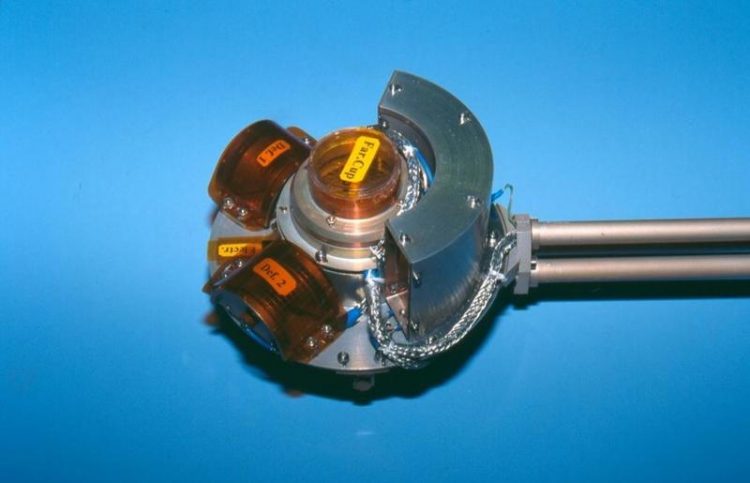Rosetta-Mission: The incredible flight of the lander »Philae«

Close up of the ROMAP-Instrument IGEP/TU Braunschweig
Just a little time after Rosetta lander „Philae“ touched down on a comet it was clear that the mission was not continuing as expected, because the lander bounced off the surface. The international team of scientists lead by geophysicist Dr. Uli Auster from the Institut für Geophysik und extraterrestische Physik was working at the „Philae“ control center at that time and followed the incredible flight of the lander.
The data obtained by the ROMAP magnetometer from Braunschweig immediatly showed the signatures of this bouncing and the subsequent touchdowns. With the data, the movement on the comet can be reconstructed.
Bounce: two hours above the comet
In the evening of 12th November, 2014, the scientists around Dr. Hans-Ulrich Auster were surprised when they saw the data of the ROMAP magnetometer immediately after touchdown: „With the magnetometer we can reconstuct the movement of the lander, just like the rotation of a compass needle. Consequently we could see instantly that „Philae“ bounced off the surface and finally returned after two hours. After evaluating our data we now have more information on the path to the final and still unknown landing site“ explained Dr. Auster.
Possible collision with a crater rim
Now the magnetic field data reveals that after the first touchdown „Philae“ started to rotate about its vertical axis, says Auster. The reason was that the reaction wheel, that was stabilizing the lander during descend, transferred its momentum to the freely moving lander. Within 40 minutes Philae accelerated to a rotational velocity of about 5 rpm, which is comparable to a wind turbine at low wind speeds“ says the geophysicist. But after 45 minutes the pattern changed suddenly: „The rotational velocity decreased to half the original speed, the axis tilted and the lander began to tumble. Most likely the reason was a collision with a crater rim“ summarized Dr. Auster.
Second landing decides Philae's fate
The magnetometer from Braunschweig shows that the lander tumbled above the surface for another hour before it jarringly touched down for the second time. „Then the fate of the lander was decided, which was also visible in magnetic field signatures. After first grazing the surface, „Philae“ landed on its feet at the last moment. After another seven minute bounce the lander arrived at its final position surrounded by icy walls“ say Hans-Ulrich Auster. „Although there was some luck involved, the astonishing landing impressively demonstrated that the lander was sturdy enough to not only withstand the harsh environmental conditions of space but also managed to survive this arduous landing sequence.”
ROMAP-Instrument
The Rosetta Lander Magnetometer and Plasma Monitor (ROMAP) is one of ten instruments on the lander „Philae“, that investigates the magnetic field and solar wind parameters of the comet 67P/Churyumov-Gerasimenko for the ESA Mission Rosetta. Lead by Dr. Hans-Ulrich Auster of the Institut für Geophysik und extraterrestrische Physik at Technische Universität Braunschweig scientists from the Energy Research center in Budapest, the Institut für Weltraumforschung Graz in Austria and the Max-Planck Institut für Sonnensystemforschung in Göttingen contribute.
Contact
Dr. Hans-Ulrich Auster
Institut für Geophysik und extraterrestrische Physik
Technische Universität Braunschweig
Mendelssohnstraße 3
38106 Braunschweig
Tel.: 0531 391-5241
E-Mail: uli.auster@tu-braunschweig.de
www.igep.tu-bs.de
Weitere Informationen:
Media Contact
All latest news from the category: Physics and Astronomy
This area deals with the fundamental laws and building blocks of nature and how they interact, the properties and the behavior of matter, and research into space and time and their structures.
innovations-report provides in-depth reports and articles on subjects such as astrophysics, laser technologies, nuclear, quantum, particle and solid-state physics, nanotechnologies, planetary research and findings (Mars, Venus) and developments related to the Hubble Telescope.
Newest articles

Properties of new materials for microchips
… can now be measured well. Reseachers of Delft University of Technology demonstrated measuring performance properties of ultrathin silicon membranes. Making ever smaller and more powerful chips requires new ultrathin…

Floating solar’s potential
… to support sustainable development by addressing climate, water, and energy goals holistically. A new study published this week in Nature Energy raises the potential for floating solar photovoltaics (FPV)…

Skyrmions move at record speeds
… a step towards the computing of the future. An international research team led by scientists from the CNRS1 has discovered that the magnetic nanobubbles2 known as skyrmions can be…





















